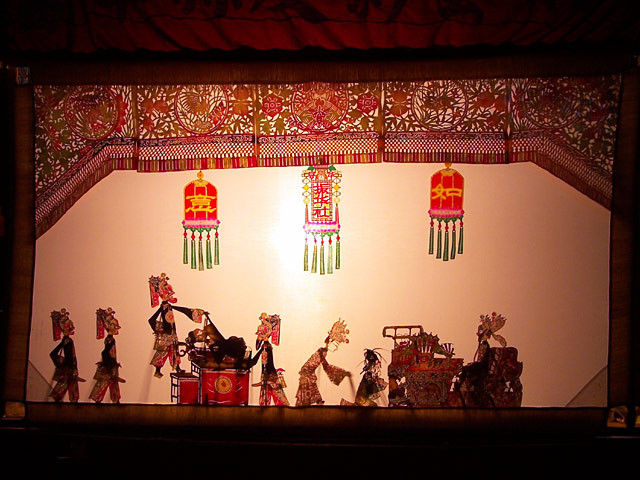Shadow Puppet Shows
In several regions of China, shadow puppetry, also known as shadow play, was particularly common during the Tang (618–907) and Song (960–1279) dynasties. Shadow puppets were initially created out of paper mâché and later were manufactured from donkey or ox leather. Their Chinese name, pi ying, which translates to "shadows of leather," is a result.
A beloved concubine of Wu Emperor of the Han Dynasty passed away from illness more than 2,000 years ago; the emperor mourned her so much that he lost the drive to rule. One day, a preacher just so happened to notice kids playing with dolls where the floor had vivid shadows. The astute minister was inspired by this incident and came up with a plan. He painted the concubine's cotton puppet after making it. He invited the emperor to see a puppet show behind a curtain as darkness fell. The emperor was ecstatic and began to enjoy it. The official history book claims that this tale is where shadow puppetry first appeared.
Politics and shadow puppetry were intertwined. For instance, this folk craft was so well-liked in Beijing during the reign of Emperor Kangxi that there were eight lavishly compensated puppeteers in one prince's palace. To make up for their inability to enjoy local amusement due to linguistic limitations, the Manchu rulers brought the puppet performance with them when they stretched their dominion to different regions of China. In order to stop the peasant insurrection from spreading during the period of 1796 to 1800, the government outlawed the public performance of puppet performances. The popularity of shadow puppet shows did not start to grow until 1821. The show is currently in danger of dying out, just like other traditional art forms like Nuo Drama.
Shadow puppetry captures an audience's attention with its lingering music, superb sculpture, brisk color, and energetic performance.
One voice speaks thousands of years of history; a pair of hands controls millions of warriors. This is how a shadow puppeteer operates. A shadow puppet group is made up of five people and is known as the business of the five. One person controls the puppets, one person plays a horn, a suo-na horn, and a yu-kin, one person plays the banhu fiddle, one person controls the percussion instruments, and one person sings. This singer takes on all of the roles in the puppet performance, which is obviously incredibly challenging. Not only that, but the vocalist also performs with over 20 different musical instruments in a puppet performance. This traditional folk art is enhanced by these archaic musical instruments.
The shadows of flat puppets are projected onto a white cloth screen that serves as the play's stage. Shadow puppets resemble paper cuts in appearance, but they may be manipulated more freely because their joints are connected by a thread. The audience is drawn in despite the scene's simplicity and primitiveness by the flawless performance. For instance, with the help of the operator, a puppet can smoke and breathe out a smoke ring. In one scene, the maid's actions are reflected in the mirror while she sits there. Each of the five puppets being played by the operator has three threads. 15 threads are held in ten fingers. It makes sense why the operator is compared to the Kwan-yin with 1000 hands.
Shadow puppets use exaggeration and dramatic dramatization to overcome the limitation caused by only seeing the profile of the puppets. Puppets' features and costumes are colorful and amusing. The floral color, beautiful sculpting, and smooth lines elevate the puppets beyond mere props to works of art. A figure requires up to 24 operations and over 3,000 cuts.
All of the figures have a broad head and a narrow, tapering torso. A man has a large head, a square face, a wide forehead, a tall, powerful frame that is not overly macho. A woman has a slim figure without being excessively lean, a small mouth, and a narrow face. For Chinese women, effeminacy and compassion are the norm. Generals with combat gear conjure up images of bravery and prowess, while scholars have a beautiful bearing and wear lengthy robes.
The figures are designed in accordance with traditional moral judgment and aesthetics. The mask of a figure might reveal his persona to the audience. A red mask, like the masks in Beijing Opera, denotes uprightness, a black mask, integrity, and a white mask, deceit. The positive figure features long, narrow eyes, a tiny mouth, and a straight nasal bridge, whereas the negative form has small eyes, a projecting forehead, and a sagging mouth. Even before performing any act, the clown has a circle around his eyes, giving a hilarious and frivolous attitude.
Shadow play includes opulent background elements like furniture, architecture, vessels, and lucky patterns. The play, being earthy art, leaves an impression on viewers with its vividness and sophistication. A framed puppet can make a unique and enjoyable keepsake.
The shadow puppets also feature historical and folkloric figures such as the Monkey King, Emperor Qin Shi Huang, or the four ancient beauties, Xi Shi, Wang Zhaojun, Diao Chan, and Yang Guifei, in addition to the characters required for a particular production. The most prevalent form of shadow puppetry is thought to be in Shaanxi. In Xi'an, the Academy Gate Cultural Street is the best spot to buy shadow puppets as gifts. Here, you can choose from hundreds of figures in various sizes and positions, each of which reveals a unique world.










